If you are seeking a freshwater fish with a stunning look for your aquarium blue texas cichlid is the best choice. The most important thing is, they are aggressive. So, when you are adding this species to your fish tank, you should consider that too. Texas Cichlids including Blue Texas Cichlids are freshwater fish species. Moreover, Blue Texas Cichlids have a feisty personality. Texas Cichlid is also known as Pearl Cichlid, as well as Rio Grande Perch. Their scientific name is Herichthys cyanoguttatus. This fish type belongs to the Cichlidae family.
The appearance of the Blue Texas Cichlids
Jump To
- 1 The appearance of the Blue Texas Cichlids
- 2 Blue Texas Cichlid size
- 3 The lifespan
- 4 Types of Blue Texas Cichlid
- 5 Behaviour of the fish
- 6 Are Blue Texas Cichlids aggressive?
- 7 Native habitats of Blue Texas Cichlids
- 8 Food preference of Blue Texas Cichlids
- 9 How often do you feed your fish?
- 10 Preferable tank condition and Tank setup
- 11 Tankmates of Blue Acara Texas Cichlid
- 12 Blue Texas Cichlid Breeding
- 13 How to identify Blue Texas Cichlid female male and female
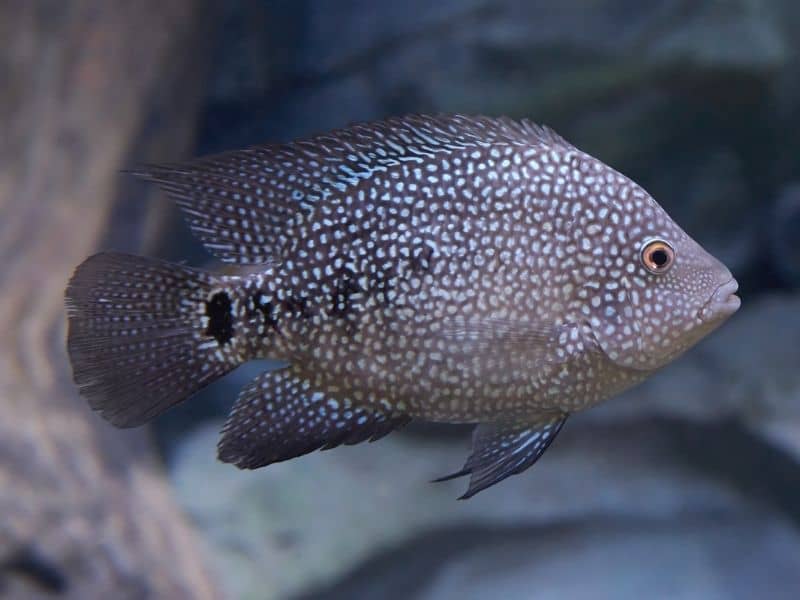
Blue Texas Cichlid is also known as Blue Cichlid. They have an attractive colour pattern. Also, an unusual dot adds more beauty to this type of fish. This dotted pattern has different size spots and these spots’ colour can vary from green to light blue. But when you see a Blue Texas Cichlid in a tank, there you can see the beautiful blue shade in their body. Because they look amazing when lights in the tank fall on their fins.
It looks like the spots within the fins lit up. These are like stars. And also dots on their body have a glow look under the light. When considering their body, they are large and they have iconic wide shapes. Blue Texas Cichlid has a slight hump on the top of their head and they have thick fleshy lips.
Blue Texas Cichlid size
Blue Texas Cichlid grows up to about 30 cm (12 inches) in length. In addition to that, they become sexually mature at about 5 cm (2 inches). You can exceed this amount by providing good care and quality food for them.
The lifespan
In general, Texas Cichlid can live between 10 and 13 years. This is their average lifespan of them. But if you provide healthy and quality foods and also optimum tank condition, this estimation can be broken. But on the other hand, if you do not care for them properly or do not provide proper diet and tank maintenance. It may cause stress and diseases. So, these can shorten the lifespan of your fish.
Types of Blue Texas Cichlid
Electric Blue Texas Cichlid
Sometimes Electric Blue Texas Cichlid is known as Electric Blue Hap or Hap Ahli. They add extra beauty to your fish tank. Their scientific name is Herichthys carintis. Electric Blue Texas Cichlid belongs to the Pearlscale Cichlid variety. This variety is remarkably colourful. These fish has amazing electric blue marbling on the entire body. They are large in size and native to Mexico. Like other types of Texas Cichlid, Electric Blue Texas Cichlid shows aggressive behaviour. You can breed them in your home aquarium.
They prefer to live in a pH range of 6.0-8.0. When comparing another Cichlid, you can care for these fish easily. So, this species can be recommended to beginners. But, the important thing to remember is, you should not keep Electric Blue Texas Cichlid with Peacock Cichlid. Because it causes territorialism and fighting.
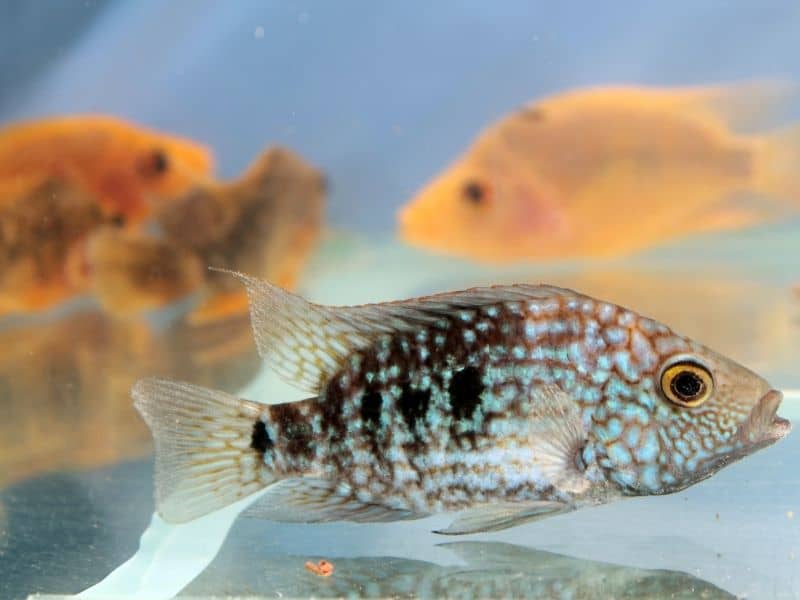
Super Blue Texas
Super Blue Texas has an oval-shaped flattened body with a big head and largemouth. The special thing is, they have the most beautiful coloration. They have blue spots spread across their body.
Blue Dot Texas
Blue Dot Texas’s body shape and features are similar to the Blue Texas Cichlids. They have dots all over their body and these dots have colours ranging from light blue to dark blue.
Blue Acara Texas
Blue Acara has dark blue coloration. The special thing of this coloration develops when the Blue Acara Texas Cichlid is in adulthood. This coloration is really striking. Most likely this Cichlid type is not aggressive. But they always try to dig in the substrate of your fish tank. If you have live plants in your fish tank, it badly affects your live plants. When comparing other cichlids, these fish are small in size. They grow up to 4 to 5 inches long. Also, they can survive their lives with a pH range between 7.0 and 7.8. you can keep your Blue Acara Texas with other South American species like Corydoras, Tetras, and Catfish.
Read more: Red Texas cichlid Care & 15 things to know
Behaviour of the fish
Generally, the behaviour of Blue Texas Cichlid is similar to other Cichlids. Normally they show aggressive and territorial behaviour. Also, are not a schooling fish type. They are very active and like to swim alone. If you have Blue Texas Cichlid, you can see, they like one thing. It is that they like to dig in the substrate of their tank. They tend to move the gravel. If you have any live aquatic plants in your tank, this behaviour may badly affect the live plants.
Thus, you should take necessary actions to that. Also, you cannot see Blue Texas Cichlid hid among the live plants and gravels. They always actively swim around the tank. Blue Texas Cichlid is very intelligent. It can conclude that the Blue Texas Cichlid have the ability to identify their owners. They know their owners who feed them and look after them.
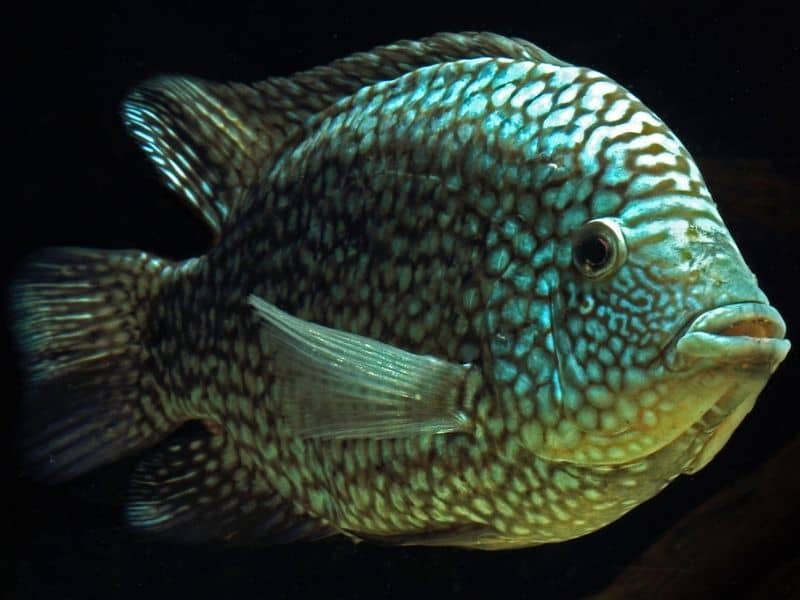
Are Blue Texas Cichlids aggressive?
Yes, they are aggressive. You can see their aggressive and territorial behavior in aquarium. They are not showing very peaceful and friendly behavior with other type of fish. Further, they are not schooling fish.
Native habitats of Blue Texas Cichlids
Texas Cichlids are the only type of Cichlids that you can see naturally in the United State. You can find them in a part of the Rio Grande River. Rio Grande River is flowing across Texas and Northern Mexico. This is the reason that this fish type is known as Texas or Rio Grande Cichlid.
Although, this fish type can be found in small ponds, lakes, and tributaries that are neighbors to the Rio Grande River. This small region has the ability to give everything that this large type of fish requires to survive and live. Rivers where Texas Cichlid live are flowing fast and water in these places has warm water conditions.
Food preference of Blue Texas Cichlids
They are omnivores. So, they eat both plant matters and animal matters. This freshwater fish tends to eat anything that you provide. You can provide all sorts of foods, frozen, live and plant-based foods. Also, if you need a healthy and happy fish, always try to provide a balanced diet. You can add frozen shrimp, blood worms, crustaceans, formulated and other live foods. Furthermore, they eat insects, small fish, insect larvae, and other small worms.
Also, you can occasionally provide plant matters to your Blue Texasfish. Some fish eats duckweed, algae, java fern, and Anacharis. Moreover, cichlid pellets, cichlid flakes, gel cichlids foods, spirulina, and seafood wafers, and freeze-dried cichlids also provide better nutrients to your Blue Texas Cichlids.
Further, you can collect vegetables and fruits from your kitchen to their diet. Here you can add Broccoli, Spinach, Cucumber, Peas, and crab. The important thing to remember is, you should chop the fruits and vegetables before you put them into the tank. Also, you should give these vegetables and fruits by matching their diets.
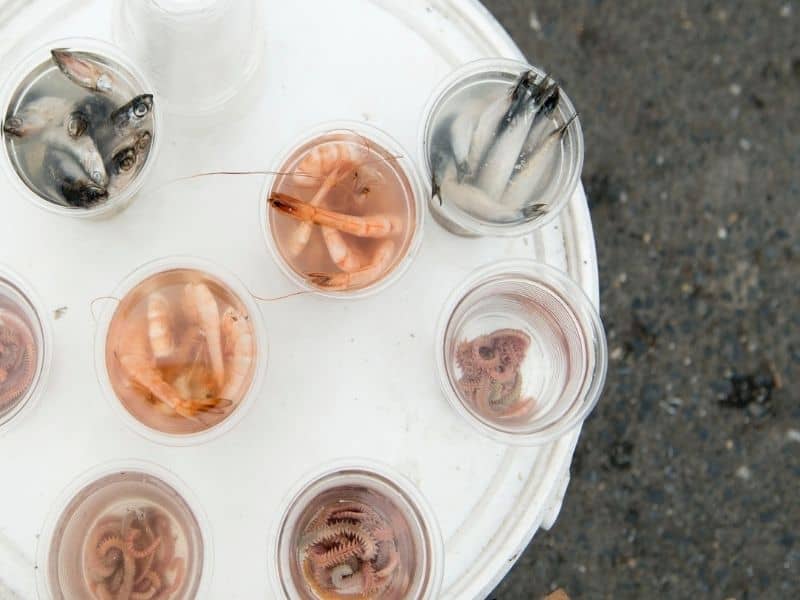
How often do you feed your fish?
Generally, you should feed your fish 2 or 3 times a day. When considering the amount that you should need to give your fish, the general rule is, approximately the amount of the food may match with the eyeballs of your fish. Also, you should put foods that Cichlid can finish within 2 or 3 minutes. After feeding, you can remove uneaten foods by using a fishnet. It helps to maintain the cleanliness of the water in the tank as well as avoids overfeeding.

Preferable tank condition and Tank setup
Tank size
You should create a large aquarium for your Blue Texas . If you put them into the small tank, they will out grow the tank. Because they have a fast-growing rate and large adult size. Because of these factors, you should build a tank with a minimum of 55 gallons capacity for a them. But you should have a 75 gallons tank for the breeding purpose. And also, you wish to keep a pair of Blue Texas, the recommended minimum tank size is 110 gallons.
If you want to keep your Blue Texas Cichlids with other fish types in the same home, you have to go for at least a 125 gallons tank. But when you put other types of fish with Blue Texas Cichlids in the small tank, it is a way to see their aggressive behaviour properly.
Preferable pH level for Blue Texas
Generally, they like to live in pH levels in between 6.5-8. They have the ability to survive in the water, basic, neutral, or just slightly acidic.
Preferable temperature level for Blue Texas Cichlids
Their survival temperature range is 71.50 F – 770 F. Most of the time, you have to set up a heater in your aquarium to control water temperature.
Preferable hardness level for Blue Texas
If you need a happy and healthy Blue Texas Cichlids, you should have to maintain your hardness of the water in the tank 8-15 dGH. Rapid change of the hardness level can badly affect your Blue Texas Cichlid.
Substrate for Blue Texas Cichlid tank
The best suitable substrate is sand. Sand substrate helps to feel your Blue Texas Cichlids live in the wild. Because the river also has a sand layer at the bottom of the riverbed. In addition to that, Blue Texas Cichlid has a behaviour to dig in the substrate. If your tank has a sand substrate, it is safer for your fish.
On the other hand, another alternative is gravel substrate. This also suits the Blue Texas Cichlid tank. If you can make the sand and gravel mixture for the bottom layer of your Cichlids tank. Surely it gives a more natural experience to your fish than another substrate.
Filter system
Blue Texas Cichlids are aggressive eaters and they produce more wastes and debris. Therefore, you should need a proper filter system to keep your Cichlids tank healthy and clean. Because water quality directly affects your Blue Texas Cichlids. Recommended filter systems for your Cichlid aquarium,
- Hang-On-Back (HOB) filters
- Canister filters
- Sponge filters with powerheads
Tankmates of Blue Acara Texas Cichlid
Generally, Blue Texas Cichlids are not schooling fish and most probably they do not welcome other fish types for their home tank. In the wild, Texas Cichlids usually live a solitary lifestyle. They tend to find pairs only in the breeding season.
Only you can control their aggressive behaviour by enlarging the tank. Sometimes they may be able to coexist with other fish species. But usually, they should be kept separately. However, if you wish to keep your Blue Texas Cichlids in the same tank with other fish species in a large tank, you should start it with juvenile Texas Cichlids.
Here, you need to remember, the young Blue Texas Cichlids need to keep with other non-aggressive fish types. But when growing Blue Texas Cichlids gradually, their behaviours are changing rapidly and they become very aggressive. However, you should keep your Blue Texas Cichlids with other fish species, you can select a few fish types to share their home tank. These species are,
- Giant Gourami
- Tambaqui,
- Eels
- Catfish
- Black Ghost Knife Fish
- Jack Dempsey Fish
- Silver Dollars
- German Blue Ram
- Most types of Plecos
- Green Terror Cichlids
- Firemouth Cichlids
- Oscar Fish
- Tinfoil Barbs
- Convict Cichlids
The important thing to remember is, you should not keep Electric Blue Texas Cichlid with Peacock Cichlid. Because it causes territorialism and fights. And also, they do not keep with schooling fish species like types of goldfish, harlequin rasboras, white cloud mountain minnow, cherry barbs, rummy nose tetra, cardinal tetra, zebra danio, platy, pygmy cory, bloodfin tetra, scissortail rasboras, red rainbowfish, congo tetra, emperor tetra, rainbow shiners and tiger barbs.
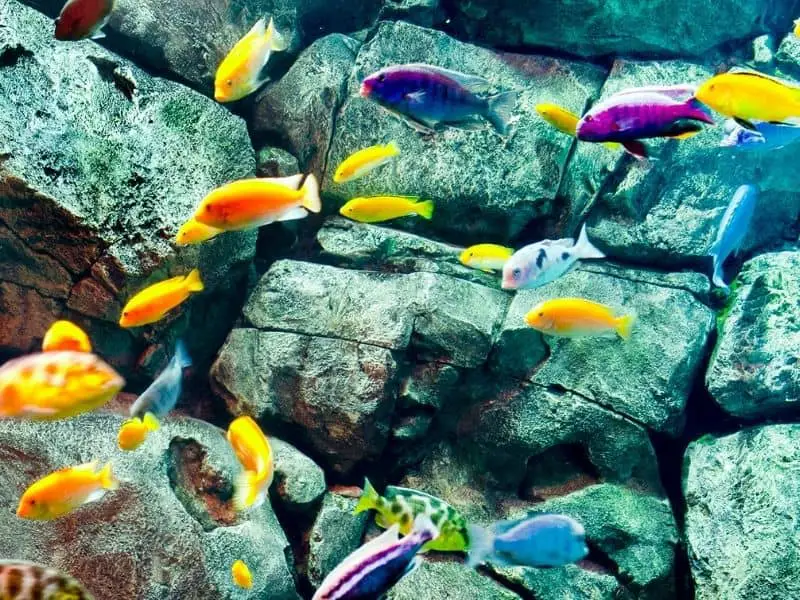
Blue Texas Cichlid Breeding
It is often difficult to create a “harmonious” couple. The best way to do this is to buy 6 young Blue Texas Cichlids or more and let them grow together. Then they will select the mating pair by themselves. In the breeding season, Texas Cichlid fish can be more aggressive. Therefore, you should take some extra precautions to do this smoothly and safely. Here you can create a separate breeding environment. To do this you can use a 75 gallons fish tank.
The temperature of this separate breeding tank should be similar to the original tank. A separate breeding tank should have a neutral pH balance. Here you can use a soft sand layer as the substrate with flat stone rock. Then you can transfer the bonded pair of fish into a separate breeding tank. Then feed them by using high protein foods. When this couple is ready to spawn, they follow a unique ritual. At this time, they tend to chase each other and also slap each other by using their tails. The pair of Texas Cichlid then prepare the area to lay eggs.
They may use flat rock or dig a hole in the sand substrate. Then female fish lays between 500 and 1000 eggs. Then the male Cichlid fertilizes those eggs. About a week after hatching, juveniles begin to swim. If you provide nutrients rich, quality foods to your juveniles, it is easy to grow them. Initially, you can give them Brine shrimp. Then, when they growing you can gradually increase the amount of the diet. Always try to provide a balanced and diversified diet for your baby Blue Texas Cichlids.
How to identify Blue Texas Cichlid female male and female
Just Like every other animal including fish, the general rule is applicable here too. It is male Blue Texas Cichlids are larger and stronger than female Blue Texas Cichlids and also, they have a larger body than female fish. Another special feature is the pronounced nuchal hump on the body of male Blue Texas Cichlids. Moreover, male Blue Texas Cichlid has elongated dorsal and anal fins. But here you can identify female Blue Texas Cichlids easily, because they have black spots on their fins.
These spots cannot be seen on male’s fins. When form a compatible couple of fish, you can see that they become increasingly aggressive. And from then on, the couple of fish begin to choose and protect their territory.
Read more : 8 Non-Aggressive Cichlids for Community Tank And Care
